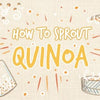Sprouting Quinoa: The Definitive Guide
Quinoa, or otherwise known as Chenopodium quinoa, is a plant species that is mostly grown for its small edible seeds. As a member of the amaranth family, quinoa is not considered an actual cereal. However, its seeds are high in nutrients such as fiber and protein.
At the same time, it also has nutritious leaves hence making it edible as a vegetable comparable to spinach. Quinoa is mostly grown in South American countries such as Bolivia and Peru on a large scale. This guide provides the essential information that you need to know about quinoa sprouts, how to grow them, and finally, how to prepare the sprouts using various recipes.
Not Much Time? Skip To What You'd Like To Learn...
-
What Are Quinoa Sprouts?
-
What Do Quinoa Sprouts Smell Like?
-
What Do Quinoa Sprouts Taste Like?
-
How Long Does It Take Quinoa To Sprout?
-
Why Sprout Quinoa?
-
Health Benefits Of Sprouting Quinoa
-
Do All Varieties Of Quinoa Sprout?
-
How To Buy Sprouting Suitable Quinoa
-
How to Sprout Quinoa
-
YouTube Sprouting Methods
-
Buying Quinoa Sprouts
-
Quinoa Microgreens
-
Sprouted Quinoa Recipes
-
How To Make Raw Quinoa Sprouts Edible For Low Immunity Groups
-
Boiling And Steaming Method To Kill Bacteria
-
Can Parrots And Birds Eat Quinoa?
-
Other Recommended Sprouted Seeds
-
Common Questions
What Are Quinoa Sprouts?
Quinoa sprouts are 1 to 2 day old shoots that germinate after exposing quinoa seeds to wet conditions. The process of sprouting quinoa seeds usually leads to a drastic increase in the content of nutrients such as amino acids, proteins, fiber, minerals, and antioxidants. Quinoa sprouts reach their peak flavor when they are at least 1/3 inch long. At this stage, their spiral-shaped roots are crispy and crunchy, while their shoots become yellow or light green.
What Do Quinoa Sprouts Smell Like?
Fresh quinoa sprouts have a mild nutty smell with earthy flavors. While the smell is reminiscent of dry quinoa seeds, the sprouting process breaks down some of the compounds stored in the seeds resulting in a milder smell.
What Do Quinoa Sprouts Taste Like?
Quinoa sprouts have a slightly nutty flavor that's close to brown rice.
How Long Does It Take Quinoa To Sprout?
Quinoa sprouts take 24 hours to sprout. The young quinoa shoots can, however, be left to grow for two days to achieve softer consistency, more nutrients, and a sweeter taste.
Why Sprout Quinoa?

For Fun - Sprouting quinoa at home can be a fun and exciting activity for most people. This is because it is an excellent activity where parents or other older individuals may involve kids. The quick germination of the quinoa shoots and roots makes both for educational and entertainment experience.
Quinoa Sprouts Have More Available Nutrients - Notably, the process of sprouting converts legumes and grains into living plants that contain more nutrients, such as fiber and proteins. These nutrients, in turn, help the human body in various ways, such as building and repairing tissues. Also, the fiber in the body is crucial for regular bowel movements and digestive health.
Quinoa Sprouts Are Easy To Digest - The process of sprouting quinoa grains helps to reduce anti-nutrients such as phytates, which causes digestion problems. Sprouting quinoa facilitates the breakdown of starches that are usually responsible for increased gases. At the same time, sprouting quinoa grains enhances the absorption of nutrients. Both soaking and sprouting of quinoa grains help to decrease the level of phytic acid, which is known to be an enzyme inhibitor that can deter the absorption of minerals and vitamins. Phytic acid can also lead to poor digestion and disrupt healthy gut bacteria.
Cooking Sprouted Quinoa Grains Is Quicker - The whole process of soaking and sprouting the grains softens them. As a result, this makes them fit for the sprouts to cook within a fraction of time as compared to those that have been dried.
Health Benefits Of Sprouting Quinoa
1. Sprouted Quinoa Grains Are Very Nutritious
The sprouting process leads to a drastic increase in the number of nutrients stored in the seed by up to tenfold. The nutrients contained in sprouted quinoa include fiber, proteins, phosphorus, folate, magnesium, manganese, iron, copper, potassium, and zinc. Quinoa sprouts also contain small amounts of vitamins, E, B6, B2, and B1, and calcium B3 or otherwise known as niacin.
Reference: link
2. Antioxidants
Sprouted quinoa contains trace antioxidants known as flavonoids that have been established to provide several health benefits as they react with free radicles in the cells which would otherwise harm healthy body organs. Kaempferol and quercetin are two flavonoid antioxidants present in quinoa sprouts that contain antiviral, anti-inflammatory, anti-depressant, and anti-cancer effects in the study of animals, including human beings.
Reference: link
3. Quinoa Sprouts Are Gluten-Free
Quinoa sprouts are gluten-free making them the perfect source of plant based proteins without having to deal with the effects of gluten-related allergies which are common in grains.
Reference: link
4. High Levels Of Protein, With All Crucial Amino Acids
Although many plant foods lack certain essential amino acids, for example, lysine, quinoa sprouts have proven to be exceptional when it comes to this issue. This is because the sprouted quinoa contains adequate amounts of all the essential amino acids. Notably, proteins consist of amino acids, with nine of them labeled as essential. This is because the human body cannot produce them but, at the same time, needs to acquire them from the diet, especially one that includes sprouted quinoa seeds.
Reference: link
5. Contains Low Glycemic Index
The glycemic index is used as a measure of how rapidly the blood sugar levels in the body are raised by food. Since eating foods with high levels of the glycemic index can contribute to obesity and also stimulate hunger, the glycemic index of quinoa sprouts is 53, which is considered as low. A low glycemic index goes a long way in supporting weight loss, reducing blood sugar, and preventing chronic complications such as heart disease and diabetes.
Reference: link
Do All Varieties Of Quinoa Sprout?
Not all varieties of quinoa seeds are sproutable. This is because some of them do not meet the threshold required for the best sprouts. In most cases, the sproutable quinoa seeds are packed and labeled to make it easier for people to acquire the best seeds that can produce excellent shoots and roots for consumption. Using any kind of quinoa seeds for sprouting may lead to unfavorable results such as rotting.
How To Buy Sprouting Suitable Quinoa
Obtaining quinoa seeds for sprouting presents the need to consider various factors that will help to ensure that the desired sprouts are obtained upon following the recommended processes and measures for sprouting. Achieving the best results in terms of nutritious sprouts is always the ultimate goal of sprouting, and therefore, choosing and sprouting the right seeds is critical in the entire process of sprouting.
Choosing The Right Quinoa For Sprouting
1. Acquire Raw Seeds
Mature, raw, and naturally dried seeds are the best quinoa for sprouting. Putting the raw seeds in water for 1 hour activates the process of germination hence making the seeds grow into a sprout.
2. Acquire Quinoa Seeds Labelled As Sproutable
Avoiding low rates of germination for quinoa seeds necessitates buying seeds that sprout ready or those that are labeled to be 'sproutable.' It is also essential to ensure that the seeds are kept in vacuum-sealed packages to prevent moisture from reaching the seeds and commencing the process of sprouting before the desired time.
3. Avoid Roasted Or Cracked Quinoa Seeds
Cracked quinoa seeds can be exposed to unfavorable conditions that would impair the beginning of the sprouting process. Any form of heat exposure such as cooking will damage the seeds preventing them from sprouting.
Considerations When Buying Quinoa For Sprouting
1. Produced For Sprouting
Quinoa seeds that have explicitly been packed for use in sprouting always provides a much higher germination rate. Quinoa seeds produced for sprouting consist of seeds that have not been subjected to pasteurization; therefore, they will absorb water naturally during the activation step and germinate.
2. Brand
Comparing various brands which offer quinoa seeds that are ready for sprouting requires an individual to choose brands that are not only well known but also have actual customer feedback and reviews. This reduces the possibility of buying damaged or low-quality seeds.
3. Source
It is vital to ensure that the quinoa seeds that you want to sprout are grown organically, non-GMO, and grown in the right climatic conditions. This step ensures that the quinoa seeds purchased adhere to the standards of FDA and that the seeds are not too old or of poor quality.
Recommended Quinoa
 Brand - Country Creek
Brand - Country Creek
Price - $7.99
Quantity - 16oz
Overview - As quinoa is sold to be boiled or soaked in hot water to cook, most commercial quinoa can be used to grow sprouts from. A very low priced option for those looking to grow sprouts, you’ll be able to grow many for a fraction of other seeds costs.
Check The Latest Price Here
Quinoa Sprout Nutrition (per 50 g serving size)
-
Calories: 188.
-
Fiber: 3g.
-
Proteins: 7g
-
Vitamin B: 10% RDA (recommended daily allowance)
-
Phosphorus: 28% RDA
-
Manganese: 58% RDA
-
Magnesium: 30% RDA
-
Zinc: 13% RDA
-
Potassium: 9% RDA
How to Sprout Quinoa
Equipment Needed
-
Large bowl
-
A dark piece of cloth
-
Fine colander or sprouting jar
-
Airtight container
Supplies Required
-
1 cup of quinoa seeds
-
Filtered water for rinsing
Method For Sprouting
1. In a large bowl, place 1 cup of quinoa then rinse and drain to eliminate dust.
2. In filtered water, completely cover your quinoa then soak for 12 hours.
3. Rinse and drain the water then transfer the soaked quinoa to a sproutable fine colander or jar.
4. Rinse your quinoa every 8- 12 hours, ensuring that all the water has been drained. Sprouting will take place within 24 hours, although you can continue with the sprouting process for 2 more days if softer consistency is desired.
5. Your quinoa can be stored for up to one week in an airtight container in the fridge.
YouTube Sprouting Methods
This tutorial provides one of the simplest ways of sprouting quinoa using simple tools such as a cloth bag, filtered or tapped water, a big pot, and nifty little sieve. Included in the video tutorial is the simplest way of cooking the sprouts for a tasty and nutritious meal.
This short tutorial by Heartsinyourfood provides simple but essential information about sprouting quinoa. For example, the YouTuber suggests that filtered water is better for sprouting quinoa as opposed to tapped water because of the impurities that may inhibit the process of sprouting.
This short tutorial first provides vital information concerning the benefits of eating quinoa sprouts. While at it, the tutor provides vital information on some of the equipment and supplies required to sprout quinoa, including a plate or tray, mesh strainer, plastic bag or sealed glass container, water, bowl, and about 3 cups of sproutable quinoa seeds.
This 8-minute tutorial by NaturalVita on sprouting quinoa seeds mainly focuses on the use of a bowl and a sieve as opposed to using a sprouting jar, which may be uneconomical to some people. The video discusses four major things related to sprouting quinoa, including what quinoa seeds to use for sprouting, how to sprout, why you should sprout quinoa seeds, and how you can enjoy your sprouted quinoa.
In this 4-minute video, Health Apta goes the extra mile to provide the best conditions for sprouting quinoa seeds, including maximum temperatures that do not exceed 32 degrees Celsius. In the video, late April is recommended as the best time to sprout quinoa seeds in the USA, with the entire process lasting between 3-4 days.
Buying Quinoa Sprouts
Where To Buy Quinoa Sprouts From
The best place to buy quinoa sprouts is grocery stores, farmers' markets, and vegan stores. These grocery stores are specialized in providing fresh, delicious, and nutritious quinoa sprouts that can make your meal more enjoyable.
Quinoa Microgreens
Can You Grow Quinoa Microgreens from Quinoa?
Quinoa microgreens are different from quinoa sprouts. Technically, quinoa sprouts are obtained when the seeds germinate and acquire a thin stem. On the other hand, encouraging the growth of the first leaves after sprouting converts the sprouts into microgreens.
How to Eat Sprouted Quinoa?
1. Burgers
Quinoa sprouts can be used to prepare vegan burgers, which are not only nutritious but are also tasty. The sprouts usually have to be precooked, which dramatically improves the taste profile to match with other ingredients such as peppers and onions. The final result is a no-frills veggie burger that's great tasting and packed full of health benefits.
2. Salads
Quinoa sprouts can be incorporated to any veggie salad to enrich the meal. The taste profile is improved using other ingredients such as cider vinegar, black pepper (freshly ground), Japanese eggplant, zucchini, and snap peas, among other ingredients.
Can You Eat Sprouted Quinoa Raw?
Quinoa sprouts can be eaten uncooked or raw. However, FDA advises that the sprouts should be cooked to eliminate any bacteria culture that may have been introduced during the sprouting process.
Are They A High-Risk Food?
Sprouted quinoa is known to be a high-risk food because it can be easily contaminated by bacteria. Eating quinoa sprouts can, therefore, cause bacterial infection and food poisoning, which may then lead to diarrhea, vomiting, and nausea, among other symptoms.
Sprouted Quinoa Recipes
Sprouted Quinoa with Marinated Veggies
This recipe was inspired by: myrecipes.com
Ingredients
-
2 cups sprouted red quinoa, uncooked
-
4 cups of slightly warm filtered water
-
½ cup of cider vinegar
-
1 ¼ teaspoon of kosher salt
-
6 tablespoons of olive oil
-
1 cup Japanese eggplant, diced
-
1 cup grape tomatoes, quartered
-
¼ teaspoon black pepper, freshly ground
-
1 cup of cut zucchini (1/2-inc-thick slices)
-
1 cup of halved cucumber slices
-
1 cup snap peas, sliced
-
1 cup of diced kohlrabi
-
1 cup of a coarsely chopped mixture of flowers and herbs (such as nasturtium, marigold leaves, and parsley)
-
2 thinly shaved garlic cloves
-
½ cup of cut orange bell pepper
-
½ cup cut jalapeno pepper
Instructions
Step 1
1. In a large bowl, mix quinoa and 4 cups of water.
2. Use a clean kitchen towel to cover the bowl and keep in room temperature for 6 hours.
3. Use a fine sieve to drain and rinse your quinoa sprouts.
4. On a rimmed baking sheet, spread your quinoa sprouts evenly and keep it uncovered at room temperature for 12 hours. Rinse and place it at room temperature uncovered for 12 more hours
5. Set aside 1 cup of sprouted quinoa and reserve the remaining 3 cups of the sprouts for another use.
6. Place in a refrigerator for up to 4 days using an airtight container.
Step 2
1. In a large bowl, combine salt, vinegar oil, and pepper and stir using a whisk.
2. Add eggplant, quinoa sprouts, and the other remaining 9 ingredients beginning with garlic.
3. Add hemp seeds and toss to combine, if desired.
4. Let stand either at room temperature or refrigerated for 2 hours then serve.
Raw Vegan Savory Sprouted Quinoa Salad
This recipe was inspired by: thespruceeats.com
Ingredients
For Vegetable Marinade:
-
1 tablespoon of nama shoyu
-
½ cup of water
-
½ teaspoon of mustard, stone-ground
-
1 teaspoon of agave nectar
-
1 minced clove garlic
-
½ teaspoon of balsamic vinegar
For Salad:
-
1 cup of quinoa sprouts
-
3 cups of vegetables, diced (such as red bell peppers, portobello mushrooms, red onion, carrots, and zucchini, among others)
-
2 tablespoons of kalamata olives, sliced (yummy but optional)
-
¼ tablespoon of sea salt
-
¼ teaspoon of black pepper
-
Pinch cayenne
-
1 tablespoon of fresh herbs, chopped (such as oregano, parsley, sage, thyme, and rosemary, among others)
Instructions
1. In a casserole dish or a bowl, mix all the ingredients of vegetable marinade using a whisk or fork alongside diced vegetables.
2. In the refrigerator, let the mixture marinate for between 30 minutes and 3 hours.
3. Add all the other remaining ingredients and quinoa sprouts. Stir well.
4. Using an airtight container, store in the fridge for 1-2 days to improve the nutritional value or serve immediately.
Sprouted Quinoa Savory Pilaf
This recipe was inspired by: allrecipes.com.
Ingredients
-
2 cups of sprouted quinoa
-
3 tablespoons of butter
-
1 cup of yellow onion, finely minced
-
2 tablespoons of garlic, minced
-
1 ¾ cups of water
-
1 ¾ cups of chicken broth
-
¼ teaspoon of thyme, ground
-
½ teaspoon of sea salt
-
2 tablespoons of flat-leaf parsley, fresh and finely minced
Instructions
Step 1
1. In a large saucepan, melt butter using medium-high heat.
2. Saute onion to soften.
3. Add garlic and sprouted quinoa.
4. Cook and stir constantly to obtain garlic fragrance
Step 2
1. Add water, salt, thyme, and chicken broth and bring to boil.
2. Reduce to simmer, cover, and cook for 17 minutes to tenderize the grains.
3. In the parsley, stir then remove from the heat.
4. For 5 minutes, let it stand covered then fluff with a fork.
How To Make Raw Quinoa Sprouts Edible For Low Immunity Groups
The re-exposure of raw quinoa sprouts to people with low immunity may expose them to bacterial infections that may lead to uncomfortable experiences such as diarrhea, vomiting, and nausea. This, therefore, requires the quinoa sprouts to be slightly cooked to kill bacteria hence making it edible for individuals with low immunity.
Who Is At Risk?
Although everyone is at risk of bacterial infections upon eating raw sprouted quinoa, other vulnerable members in society are at higher risk of experiencing severe effects of the bacteria. They include;
-
HIV & AIDS patients
-
Cancer patients
-
Children
-
Pregnant women
-
Patients using immunosuppressants
Boiling And Steaming Method To Kill Bacteria
When sprouted quinoa is exposed to high temperature helps to kill or disable the dangerous bacteria that might lead to contamination of the sprouts
Equipment Required
-
Wooden steam bucket
-
Large pot
Method
1. In a halfway-filled large pot, use medium heat to bring it to boil
2. For boiling the sprouts:
-
add the sprouted quinoa into the already boiled water for 15-20 minutes.
3. For steaming the quinoa sprouts:
-
In the pot of boiling water, place the wooden steam bucket and add the sprouted quinoa then cover.
-
Let the quinoa sprouts steam for 25-30 minutes.
Can Parrots And Birds Eat Quinoa?
Parrots can eat quinoa sprouts either raw or cooked while still providing the required nutrients. The sprouts are especially rich in protein content which parrots require to grow muscles and replace worn out tissues.
Do You Need To Grow Quinoa Sprouts Differently For Parrots?
There is no different way for sprouting quinoa for a parrot(s) unless the seeds are not healthy for the parrots to the consumer. Otherwise, similar methods used to sprout quinoa for human consumption should be applied when sprouting quinoa for your parrot(s).
Other Recommended Sprouted Seeds
Soybeans: Raw soybeans have a very strong yet 'beany' flavor as opposed to cooked beans
Chickpeas: Its seeds have a satisfying, nutty flavor and slightly grainy texture that makes a wonderful contrast as compared to other ingredients. They are grown either in a subtropical or tropical climate. They also come from plants with pods, just like other legumes.
Lentils: The flavor of lentils is rich and earthly. Although they can be squashed easily, they hold their shape well and can be cooked for 25-30 minutes.
Buckwheat: They have a little bitter, a little nutty, and a little earthy taste, and their flavor can be intense. When buckwheat seeds are roasted, its taste becomes tamed.
Broccoli: It has a nice yet mild flavor, which gives it an advantage over other green vegetables with bitter flavors such as spinach, chard, and kale.
Common Questions
Can You Eat Quinoa Sprouts?
Sprouted quinoa is edible, uncooked or raw, although health experts advise that it should be cooked to kill bacteria.
What Does It Mean To Sprout Quinoa?
Sprouting quinoa incorporates soaking in water, rinsing numerous times, and spreading on trays to obtain sprouts within 48 hours.
How Long Does Sprouted Quinoa Last?
Sprouted quinoa can last for 2 weeks after being dried out and stored in a sealed glass container or sealed plastic bag in a refrigerator to ensure freshness and keep cool.
How Do You Activate Quinoa?
Put quinoa grains in a measuring cup or glass bowl and stir in filtered water. Use a tea towel to cover and leave to soak for 12 hours.
Should I Rinse Sprouted Quinoa?
It is essential to rinse quinoa sprouts to remove dust and other small particles that may have found their way into the seeds/grains.
Is Quinoa Poisonous?
Quinoa grains contain saponin, a soapy and bitter substance that prevents quinoa plants from attacks by insects and fungus. Additionally, it comprises toxins that may irritate.
Can I Eat Uncooked Quinoa?
Quinoa sprouts can be eaten raw. However, health experts advise that it should be cooked to kill bacteria that may cause health complications such as vomiting, diarrhoea, and nausea.
Is sprouted Quinoa Better Than Regular Quinoa?
Yes. This is because sprouted quinoa contains more available nutrients as compared to regular quinoa. These nutrients include vitamin C, iron, folate, protein, and magnesium, among others.
Can You Eat Quinoa Everyday?
Health experts have established that eating a bowl of quinoa sprouts daily can save your life by reducing premature death caused by cancer, respiratory disease, heart disease, and diabetes.
Can You Put Raw Quinoa In A Smoothie?
Raw, uncooked quinoa can be blended into a smoothie to make high fiber, high protein breakfast, or meal replacement during any time of the day.
Can You Eat Raw Quinoa Sprouts?
Raw quinoa sprouts are edible, except that it may contain harmful bacteria. Therefore, cooked quinoa sprouts are recommended by health experts because it is tastier, more nutritious, and free from harmful bacteria.
Do You Toast Quinoa Before Or After Rinsing?
Gone are the days when one had to rinse quinoa several times to remove saponin on the seed. Instead, most bulk quinoa that are commercially available are pre-rinsed.







